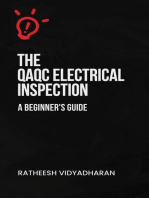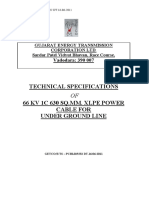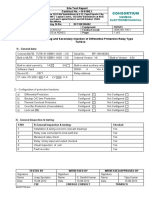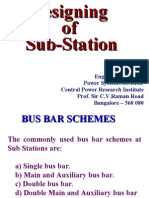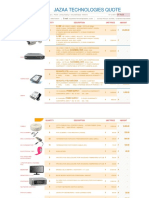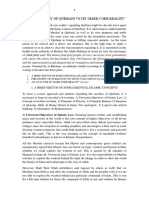132 KV
132 KV
Uploaded by
Wan Zamani Wan AbdullahCopyright:
Available Formats
132 KV
132 KV
Uploaded by
Wan Zamani Wan AbdullahOriginal Description:
Original Title
Copyright
Available Formats
Share this document
Did you find this document useful?
Is this content inappropriate?
Report this DocumentCopyright:
Available Formats
132 KV
132 KV
Uploaded by
Wan Zamani Wan AbdullahCopyright:
Available Formats
Gas Insulated Substations EXK-0
for installations up to 145 kV, 2500 A, 40 kA
.
.
.
.
.
.
.
.
.
.
.
.
.
.
.
.
.
.
.
.
.
.
.
.
.
.
.
.
.
.
.
.
.
.
.
.
.
.
.
.
.
.
.
.
.
.
.
.
.
.
.
.
.
.
.
.
.
.
.
.
.
.
.
.
.
.
.
.
.
.
.
.
.
.
.
Power
IT
Power
IT
B 2
Content
General nnn 4- 5
Set-up of a substation nnn 6-7
The system and
its components nnn 8-19
Busbar with combined disconnector
and earthing switch
Circuit breaker with current transformer
Hydromechanical spring operating mechanism
Cross unit with combined disconnector
and earthing switch
Make-safe earthing switch
Current and voltage transformer
Cable sealing end
SF
6
outdoor bushing
Supplementary modules
Control cubicle
Transport, installation, nnn 20-21
and maintenance
Version examples nnn 22-30
Double busbar
Single busbar
H-circuit
Y-circuit
1
1
2-breaker method
Mesh substation
Technical data 31
Space-saving design, low weight, and short delivery time
characterize the Power
IT
GIS EXK- 0
.
.
.
.
.
.
.
.
.
.
.
.
.
.
.
.
.
.
.
.
.
.
.
.
.
.
.
.
.
.
.
.
.
.
.
.
.
.
.
.
.
.
.
.
.
.
.
.
.
.
.
.
.
.
.
.
.
.
.
.
.
.
.
.
.
.
.
.
.
.
.
.
.
.
B 4
Since the presentation of the
first SF
6
-insulated 110-kV-switch-
bay in the year 1965, ABB has
been among the pioneers of this
technology
Nowadays the range of high-voltage
applications includes several series
of modular Power
IT
Gas Insulated
Substations (GIS) for rated voltages
of between 52 kV and 800 kV.
Over 2,000 stations with more than
10,000 switch bays demonstrate
their value every day in 70 countries.
Extensive experience in plant opera-
tion in a wide variety of conditions
and with many different requirements
forms the valuable basis of the needs-
oriented development and production
of our gas-insulated substations,
with their recognized high quality.
Characteristic advantages
of the Power
IT
GIS EXK-0 are
Space saving, compact design
High availability
Low maintenance and repair
requirements
Short delivery and commissioning
period
Consistent modular technology
General
Busbar wit h combined disconnect or
and eart hing swit ch
.
.
.
.
.
.
.
.
.
.
.
.
.
.
.
.
.
.
.
.
. . . . . . . .
Modular syst em for opt imum
subst at ion layout
B 6
An ingenious modular system
makes possible a variety
of solutions
Power
IT
Gas Insulated Substations
(GIS) EXK-0 are created by the com-
bination of standardized function
modules such as circuit breakers,
disconnectors and earthing switches,
instrument transformers, supplemen-
tary modules, etc. These 3-phase
modules are connected together by
means of carefully machined flange
connections.
The dimensions of these flanges are
the same with all modules, so that
various components can be com-
bined very freely. This facilitates the
design of a substation and its plan-
ning.
The ingenious modular system offers
the planning and project engineer
great flexibility for optimization. He
can thus easily realize his concepts
of the optimum configuration for the
substations. Various criteria such
as basic circuit, routing of lines and
cables, building size, accessibility, and
provisions for extensions and rapid
fault rectification are evaluated indivi-
dually and taken into consideration
accordingly.
With Power
IT
GIS all basic circuits
used in classic substation construc-
tion can be realized. Substations with
single or multiple busbars optionally
with transfer busbar also can be
created with standard modules just
as well with disconnectable or switch-
able busbars and bus couplings.
The circuits using the two-breaker
and one-and-a-half-breaker methods
and mesh substations usual outside
Europe can also be produced econo-
mically.
Set-up of a substation
7 B
Bay wit h double busbar
and cable connect ion
0
Busbar with combined
disconnector and
earthing switch
O
Circuit breaker
O
Current transformer
O
Voltage transforme
O
Line disconnector
with earthing switch
O
Make-safe earthing switch
6
Cable sealing end
O
Control cubicle
O
O
O
0
6
O
O
O
B 8
The functions of the individual com-
ponents, and thus also of the
substations, are dependent on the
increasingly strict system require-
ments for electrical networks and
their equipment, e.g. economy, safety,
and quality. Here, an appropriate
solution is: Power
IT
GIS compact
design, flexible application, extremely
reliable primary and secondary tech-
nology.
Uniform, standard modules, which
are type-tested and manufactured in
large numbers, are joined to form
individual systems. Structures with
great functional complexity are crea-
ted by the combination of clearly
defined elements. This concept is
a precondition for effective, compre-
hensive quality assurance.
Busbar with combined discon-
nector and earthing switch
The busbar is made by adjoining
busbar components. The length
of these elements corresponds to
the bay width of 800 or 1000 mm.
Gas-tight barrier insulators in every
switch bay avoid time consuming
gas filling and emptying of large gas
compartments. Telescopic transverse
assembly elements facilitate tasks
necessary for on-site assembly and
plant extensions or conversions.
The busbar phase conductors are
fastened bay by bay to gas-tight bar-
rier insulators. These insulators are
each combined with a telescopic
transverse assembly element, which
facilitates the work necessary in event
of station extensions or conversions.
Removable plug-in contacts in the
transverse assembly element connect
the busbar conductors. Alternations
in length caused by temperature
fluctuations are thereby flexibly com-
pensated. Mechanical strains on
the insulators due to differing heating
of the individual conductors and
the enclosures are thus completely
avoided.
A combination of busbar discon-
nector and maintenance earthing
switch is an integral part of each
busbar module. The operating
mechanism comprises, beside the
step-down gear a click-stop device,
which complements the electric
locking of the two switching devices
mechanically. Gears and gear racks
convert the rotary movement of the
insulating shafts to axial movement
of the contacts.
The system and its components
Disconnect or act ive part
Disconnect or operat ing mechanism:
direct drive
Position indicators and auxiliary swit-
ches are positively connected to the
operating mechanism. Furthermore,
as the switching does not take place
until immediately before the contact
end positions are reached, an
accurate overview of the contact
position is therefore always assured.
By means of a crank handle, manual
operation of the combined discon-
nector and earthing switch is also
possible.
Busbar wit h combined disconnect or
and eart hing swit ch
0
Contact pin
O
Disconnector contact
O
Earthing switch contact
O
Barrier insulator
O
Transverse assembly
element
O
O
0
O
O
.
.
.
.
.
.
.
.
.
.
.
.
.
.
.
.
.
.
.
.
.
.
.
.
.
.
.
.
.
.
.
.
.
.
.
.
.
.
.
.
.
.
.
.
.
.
.
.
.
.
.
.
.
.
.
.
.
.
.
.
.
.
.
.
.
.
.
.
.
.
.
B 10
Circuit breaker with
current transformer
The circuit breaker is equipped with
two or three connection flanges. Their
position and form is determined by
the station layout. As all other mo-
dules can be connected directly, by
means of appropriate project planning
very compact and thus inexpensive
stations can be formed.
The circuit breaker works as a single-
pressure breaker according to the
auto-puffer principle with one break
per pole, and therefore requires very
little maintenance. The arcing cham-
ber used in this breaker arises from
the outdoor circuit breaker, which
is tested under the most stringent
conditions. It is characterized by the
consistent separation of the continu-
ous-current contacts and the auxiliary
contacts for the arc extinction.
Long-life auxiliary contacts for arc
extinction and the absence of contact
erosion at the continuous-current
contacts make the need for inspec-
tion and maintenance rare and in
most cases even superfluous.
The puffer piston connected to the
contact nozzle generates the SF
6
gas flow necessary for arc extinction
during the switch-off movement. In
contrast to the usual puffer piston
breaker, the auto-puffer breaker is
equipped with a two-stage blast
volume. The partial volumes are
separated from each other by means
of a freely movable non-return flap.
In the compression volume, the SF
6
gas is compressed during the switch-
off movement. The gas suppresses
the operating currents and small
short-circuit currents. Compression
volume and contact geometry are
optimized with regard to low over-
voltage, soft extinction behavior.
In the heat-up volume, the energy
present in the short-circuit arc is used
to heat the SF
6
gas. The pressure
thus created serves to extinguish
short-circuit currents up to the rated
breaking current. The compression
power to interrupt the short-circuit
currents is thus not performed by
the breaker operating mechanism.
The operating mechanism a spring-
assisted hydraulic mechanism is
used can therefore be made es-
pecially simple and reliable.
The majority of the switching opera-
tions are normal-load operations;
most switching operations are thus
performed with the lower mechanical
load from the compression
volume. Reaction forces and wear are
accordingly low.
Circuit breaker assembly
0
Breaker closed
O
Interrupting
operating current
O
Interrupting
short-circuit current
B Heat-up volume
B Compression volume
0
Aut o- puffer principle
O O
.
.
.
.
.
.
.
.
.
.
.
.
.
.
.
.
.
.
.
.
.
.
.
.
.
.
.
.
.
.
.
.
.
.
.
.
.
.
.
.
.
.
.
.
.
.
.
.
.
Circuit breaker wit h int egrat ed
current t ransformer
0
Arcing chamber
O
Current transformer
O
Barrier insulator
O
Hydraulic operating
mechanism
O
O
0
O
B 12
.
.
.
.
.
.
.
.
.
.
.
.
.
.
.
.
.
.
.
.
.
.
.
.
.
.
.
.
.
.
.
.
.
.
.
.
.
.
.
.
.
.
.
.
.
.
.
.
.
.
.
.
.
.
.
.
Hydromechanical spring
operating mechanism
The hydromechanical spring operating
mechanism of the circuit breaker
forms an ideal connection for the
wear-free power transmission of the
hydraulics system, with the robust-
ness of a mechanical energy accu-
mulator. A Belleville spring assembly
serves as an energy accumulator.
Its excellent qualities include reliability,
long-term stability and independence
of temperature.
The operating mechanism for three-
pole switch actuation comprises
four functional modules: recharging
module with hydraulic pump and low-
pressure tank, accumulator module
with Belleville spring assembly,
working module with drive piston
and integrated end-position damping
and a monitoring and control module
with open-close control coils. In the
version for single-pole actuation,
there are three working and control
modules respectively.
Tripping and enabling of the drive
energy is by means of tried and
tested hydraulic drive technology
components. In accordance with
the accepted safety philosophy,
the close-open changeover valve
is equipped with two redundant open
coils.
The operating mechanism has no
pipe or screw connections. The num-
ber of sealed points to the outside
is kept to a minimum. Pressurized
sliding gaskets are arranged so that
unavoidable leaks can only reach
the low-pressure reservoir and never
reach the outside.
0 I
Hydromechanical spring operat ing
mechanism Basic diagram 0
Low pressure oil
O
High pressure oil
O
Hydraulic pump
O
Drive piston
O
Changeover valve
O
Storage spring
O O 0
O
O O
13 B
.
.
.
.
.
.
.
.
.
.
.
.
.
.
.
.
.
.
.
.
.
.
.
.
.
.
.
.
.
.
.
.
.
.
.
.
.
.
. . . . . . . . . . . .
The high- and low-pressure reservoirs
are hermetically sealed, excluding the
possibility of long-term change to the
hydraulic fluid caused by oxidization.
Hydromechanical spring operat ig mechanism
for t hree- pole act uat ion
Hydromechanical spring operat ig mechanism
for single- pole act uat ion
B 14
Cross unit with combined dis-
connector and earthing switch
The line disconnector is located in
a cross-shaped module. It is com-
posed of the same active elements
as the busbar disconnector. Integral
component of the disconnector
is a motor-driven earthing switch.
In addition, this disconnector provides
the possibility of connecting a voltage
transformer. Here, the electrical con-
nection is made either before or after
the isolating distance, so that the vol-
tage is either displayed for the station
side or the line side. The connecting
flange for the voltage transformer also
serves as a test flange for the high-
voltage test of the substation or the
cable.
In general this module is combined
with a voltage transformer, a make-
safe earthing switch, and a cable
sealing end or a pipe outlet line.
Line disconnect or wit h
cable sealing end
Make- safe eart hing swit ch assembly
Combined disconnect or and eart hing swit ch
0
Contact pin
O
Disconnector contact
O
Earthing switch contact
O
Barrier insulator
O
Transverse assembly element
O
Plug-in cable connection
0
O
O
O
O
O
15 B
Make-safe earthing switch
The make-safe earthing switch is
fitted with a spring operating mecha-
nism which makes contact switching
very fast. It is therefore particularly
suitable as a line earthing switch,
as any conceivable effects in the case
of incorrect switching are thus small.
The closed earthing switch can be
isolated from the operational earthed
enclosure during an inspection. There
is therefore the possibility of creating
an electrical connection from outside
via the housing of the earthing switch
and the movable contact pins, which
are insulated from each other, to the
main circuit. This considerably facili-
tates the adjustment and checking of
the protective relays, cable checking,
and locating cable faults. During
operation, the insulation is short-
circuited.
Make- safe eart hing swit ch
Make- safe eart hing swit ch
0
Contact pin
O
Female contact
O
Insulation
O
Earthing connection
O 0
O
O
B 16
.
.
.
.
.
.
.
.
.
.
.
.
.
.
.
.
.
.
.
.
.
.
.
.
.
.
.
.
.
.
.
.
.
.
.
.
.
.
.
.
.
.
.
.
.
.
.
.
.
.
.
.
.
.
.
.
.
.
.
.
.
.
.
.
.
.
.
.
.
Current and voltage transformers
For measurement and protection
purposes inductive, single-phase
current and voltage transformers are
used. For both transformers the
primary insulation consists of SF
6
gas. The transformers are particularly
operationally safe, as this insulation
material is not subject to any aging.
Feeder current transformers are
arranged in the junction flange of the
circuit breaker. The available core
volume was determined to allow
installation of up to four cores.
The current transformer is designed
as a low-voltage transformer. The
available transformation ratios, secon-
dary outputs, accuracy classes, etc.
of the transformers correspond to the
usual requirements of modern protec-
tion and measurement technology.
The voltage transformer has a so-
called SF
6
film insulation. Here, the
individual layers of the winding are
insulated from each other by means
of plastic film and the intermediate
spaces have been impregnated in a
special process with SF
6
gas. On the
secondary side of the voltage trans-
formers, two measurement windings
and one open delta winding may
be provided for earth fault detection.
Volt age t ransformer
O
0
O
O
O
0
Primary winding
O
Secondary winding
O
Transformer core
O
Terminal box
O
Barrier insulator
Busbar- side volt age t ransformer
.
.
.
.
.
.
.
.
.
.
.
.
.
.
.
.
.
.
.
.
.
.
.
.
.
.
.
.
.
.
.
.
.
.
.
.
.
.
.
.
.
.
.
.
.
.
.
.
.
.
.
Cable sealing end
By means of the cable sealing end,
cables of any kind can be connected.
For the XLPE-insulated cables mostly
in use today, there is a cable sealing
end with a short installation length
and a completely dry solid insulation.
The main elements of the plug-in
sealing ends are the plug-in sockets
made of epoxy resin and the cable
connectors with the pre-manufactu-
red stress-cones made of silicone
rubber. An advantage is the con-
sistent separation of the substation
and cable system installations.
For other types of cable, a sealing
end is selected of which the main
component is the longer cable insu-
lator for liquid-filled sealing ends.
Gas- t ight compact cable sealing end
B 18
SF
6
outdoor bushing
The outdoor bushing allows the tran-
sition from the enclosed substation to
overhead lines or the bare connection
of transformers.
Plastic compound bushings are pre-
ferably used. They are characterized
by a fiber-reinforced support pipe
made of epoxy resin with vulcanized
shields made of silicone rubber.
These bushings are fracture- and
explosion-proof, easy to handle and
have excellent pollution layer charac-
teristics on account of the hydro-
phobic insulation material. Upon
customer request, traditional capa-
citor bushings can also be provided
with porcelain insulation.
Supplementary modules
With regard to station layout various
connection modules may be required
for combination of the equipment.
These are primarily:
Pipe connections
Angle pieces
T-pieces
The components are equipped with
a support or barrier insulator. Plug-in
and tulip contacts serve for connec-
ting the conducting paths.
Occasionally, station sections are
combined with a transverse assembly
element in order to facilitate subse-
quent station modifications, exten-
sions or repairs.
SF
6
gas system
In accordance with the dual function
of the SF
6
gas as arc extinction and
insulating medium we differentiate
between the extinguishing gas com-
partments, and the insulating gas
compartments of the busbars,
disconnectors, instrument transfor-
mers, etc. The gas compartments are
segregated by gas barrier insulators
and the gas pressure is monitored by
temperature compensated pressure
relays (density related relays).
All gas compartments have their own
automatic vacuum coupling, so that
all maintenance jobs, like drawing
a gas sample or topping-up the
SF
6
gas can be carried out without
difficulty.
Overhead line connect ion
Direct t ransformer connect ion and
t ransverse assembly element
19 B
Control cubicle
The auxiliary electrical units required
for command input, warning, locking,
etc. are accommodated in their own
individual control cubicles.
The units are connected to the con-
trol cubicles by means of control
cables with coded multiple connec-
tors. These connections are already
manufactured and tested in the fac-
tory. The electrical connections
between control cubicle and control
room are routed on terminal strips.
Located behind the glass door is the
mimic diagram with the position indi-
cators, associated control switches
and visual alarm indicators. By means
of key-switches, the units locks are
released or switched to local or re-
mote control.
Cont rol cubicle
B 20
Factory-assembled and -tested
substations
Thanks to the low weight of the
EXK-0 components, transportation
and assembly of a substation is easy.
Preferably, EXK-0 substations are
supplied in completely assembled
and tested bays with the relevant
control cubicles.
Here, the following advantages may
be applicable:
The assembly period at the instal-
lation site is very short and the
work for substation commissioning
is uncomplicated.
The insulating property has been
proven in the factory by means
of unit tests of the complete bays.
As here a partial-discharge
measurement was also carried
out, impairment of the insulating
property due to material or manu-
facturing faults can be safely ruled
out.
On account of the small bay
dimensions and weights, EXK-0
substations can also be delivered
by air freight without problem.
Complicated packaging and
preservation are not required,
so commercial use of the station
can start earlier.
After the station has been set up, the
gas compartments are filled with SF
6
gas. For this purpose, special service
trolleys are available. As all gas com-
partments are provided with valve
couplings which can be opened
without gas or pressure loss, these
operations are very simple to per-
form. Gas losses and emissions are
therefore almost completely elimina-
ted. After the switchgear has been
checked for perfect mechanical
operations, the results of the commis-
sioning tests are recorded.
Transportation,
assembly, and maintenance
Air- freight short ens t he delivery t ime
.
.
.
.
.
.
.
.
.
.
.
.
.
.
.
.
.
.
.
.
.
.
.
.
.
.
.
.
.
.
.
.
.
.
.
.
.
.
.
.
.
.
.
.
.
21 B
Operat ing mechanism and secundary t echnology
are well accessible
Maintenance
The operational safety of fully encap-
sulated SF
6
insulated substations
is subject to no external influence
resulting from dirt, moisture or similar.
Power
IT
Gas Insulated Substations
EXK-0 therefore require extremely low
maintenance.
In the case of inspections, the inside
of the switchgear is not interfered
with, so the substation can remain
in operation. The condition of the
gas and hydraulic oil is checked and
the actuators, auxiliary contact units,
density monitors are subjected to a
function test.
Circuit-breakers and disconnectors
should be inspected only after 5,000
mechanical operating cycles. In addi-
tion, repair of the circuit-breaker is
scheduled after approx. 10-20 short-
circuit cut-outs at the earliest, depen-
ding on the switched-off short-circuit
current.
Experience shows that these limit
values are far in excess of the re-
quirements of practical operation.
With respect to network planning,
the usual precautionary measures
and redundancies can therefore be
considerably reduced.
B 22
Gas insulated EXK-0 substations are
always the right choices when the low
space requirements are an important
decision criterion: for supplying power
to cities and conurbations, industrial
complexes and when aggressive
environmental conditions necessitate
a sheltered location.
All the usual station circuits can be
optimally implemented on account of
the modular component system. At
the same time, it is possible to take
into consideration the various require-
ments regarding building dimensions,
subsequent station extensions, secu-
rity of supply, comprehensive station
overview, access to equipment,
protection concept etc. on the basis
of a solution tailored to the individual
case in accordance with its value.
The following examples prove the
flexibility of the system and are in-
tended to provide stimulus for the
conception and planning of new
substations.
The bay width is basically 1 m,
or 0.8 m with the most compact
design. The required building depth
is generally 6 m, the ceiling height
less than 5 m. No crane is neces-
sary for assembling the factory-
assembled and -tested switch bays
and maintenance of the equipment;
however, installation of a crane is
recommended to facilitate the work
and to save time.
Version examples
Subst at ion wit h double busbar
and cable connect ions
8265
13300
Feeder E02, E06
3
5
8
0
8265
E02 E03 E04 E05 E06
3580 500
2
8
2
5
3
6
0
0
5
0
0
6
0
0
0
1000
E01 E02 E03 E04 E05 E06 E07
Reserve Reserve
1000
23 B
Double busbar
This circuit is the most common cir-
cuit version for important key-point
substations, power plant supply etc.
If both busbars are operated with
equal priority instead of the opera-
ting method with main and reserve
busbars the principle of busbar se-
paration can be applied to reduce the
short-circuit current. The two busbars
and their feeders belong to separate
sub-networks. If required, individual
feeders can be allocated to the other
sub-network. This concept relieves
the networks and their equipment
as a result of low short-circuit loading,
longer maintenance intervals and
offers greater supply security.
The possible coupling versions
are particularly varied: The simple
bus coupling or the combined bus
sectionalization and coupling with
six or eight disconnectors are two
examples. Double disconnectors even
allow subsequent high-voltage tests
after station extensions or mainte-
nance measures during partially
normal operation.
E02 E03 E04 E05 E06
Subst at ion wit h double busbar and
cable connect ions
Single busbar
Smaller stations or single- or double-
feed stations are frequently designed
with single busbars. Here, in the in-
terest of adaptable system manage-
ment, bus section couplings and bus
couplings are provided. This means,
for example, that part of the station
can remain in operation during station
extension work.
The layout of a station with simple
busbar is similar to that of double
busbar stations, as only the lower
or upper busbar is eliminated. If the
appropriate connection flanges are
already provided on the circuit-brea-
kers on the initial version, it is easy
subsequently to upgrade to a double
busbar.
3- bay subst at ion wit h single busbar
E01 E02 E03 E04 E05
Feeder E02
3580
5
0
0
5
6
6
0
Feeder E01
2
8
2
5
3
6
0
0
B 24
25 B
8000
6
0
0
0
1
5
0
0
E01 E02 E03 E04 E05
3
5
7
6
500
10300
E01 E02 E03 E04 E05
B 26
H-circuit
The H-circuit is often used to supply
industrial companies or smaller
regions. Two feed lines and two step-
down transformers are optimal with
regard to supply reliability and net-
work reserves. The station can be
operated as a double-feed station,
with closed cross connection also
as a ring substation. Frequently, ring-
stations with H-arrangement are
carried out without circuit breakers
in the line feeders.
If a subsequent station extension is
under consideration, the single bus-
bar with section coupling is selected
as basic layout. There is even subse-
quently the possibility of converting
this to a station with double busbar
and bus coupling. If subsequent
possibilities for extension are not
required, the especially compact
version without busbar is selected.
E01
E03
E04
E05 E02
E01 E03 E04
Q1 Q1 Q9 Q1
Q51 Q51 T1 T2 Q53 Q51
E01 E04
E05
E03
E02
E01
(E04)
E02
(E05)
4736
5
5
8
5
27 B
E01 E02 E03 E04 E05
4500
1000
4500 1000
E01 E02 E03 E04 E05
7000
6
0
0
0
3
5
8
0
500
2
3
5
0
E01 E02 E03 E04 E05
.
.
.
.
.
.
.
.
.
.
.
.
.
.
.
.
.
.
.
.
.
.
.
.
.
.
.
.
.
.
.
.
.
.
.
.
.
.
.
.
.
.
.
.
.
.
.
.
.
.
.
.
.
.
.
.
.
.
.
.
.
.
.
.
.
.
.
.
.
.
Y-circuit
In subtransmission networks the
open-loop or closed-loop operations
prevail upon star operation owing
to the better supply reliability. From
terminal stations usually with double
or multiple busbars the energy, fed
in from the superposed transport
networks or from directly connected
power plants, will be distributed via
line or cable rings to some or several
step-down stations close to the
customers.
Often the step-down stations have
only one single transformer. Such
configuration with two line feeders
and one transformer bay is also called
ring station. These stations usually
have no circuit breaker in the trans-
former bay. The transformer pro-
tection then is done by the circuit
breakers in the line feeders. If the
interruption of the line ring in the
event of a transformer failure is not
accepted, a third circuit breaker
must be provided.
B 28
E01 E02 E03
3580
2
3
5
5
3
6
0
0
6
0
0
0
3
5
8
0
500
1080 3375
7000
3400
2
3
7
5
E0 E02 E03
Ring st at ion
.
.
.
.
.
.
.
.
.
.
.
.
.
.
.
.
.
.
.
.
.
.
.
.
.
.
.
.
.
.
.
.
.
.
.
29 B
1
1
2-breaker method
The 1
1
2-breaker method is a traditio-
nal circuit with which the non-availa-
bility of the circuit-breaker during
maintenance is taken into particular
consideration. It is used primarily with
maintenance-intensive breakers, and
where the secondary medium-voltage
network does not take even a brief
additional load, or a primary transmis-
sion network is not provided.
Such networks or stations are usually
operated in such a way that all
switches are closed. Each feeder
is then fed from two sides, so that
even a faulty busbar can be switched
off without reducing the supply.
14000
9400
1000
8
0
0
0
5
0
0
0
E01 E02 E03 E04 E05 E05 E07 E08 E09
E01 E02 E03 E04 E05 E05 E07 E08 E09
Feeder E04, E07, (E01)
8000
3
6
0
0
2
3
5
5
5
0
0
.
.
.
.
.
.
.
.
.
B 30
Mesh substation
Similarly to the 1
1
2 breaker method,
the ring bus allows uninterrupted
operation of all cable and line feeders
even in the event of switchgear main-
tenance work. With this circuit, the
number of breakers and the cable
and line feeders is equal, so the
station is in general more inexpensive
than a corresponding version with
1
1
2 breakers per bay.
Preferentially small substations with
for instance four bays are built-up
with this layout. Switching of one fee-
der implies at least short-time inter-
rupting the ring-busbar. This is inap-
propriate for big substations, because
in the case of a short-circuit failure
the unplanned opening of the ring
busbar causes considerable load-flow
variations or supply interruptions.
E01 E02 E03 E04 E05 E06 E07
Feeder E03, E05
7000
5
0
0
3
6
0
0
2
3
5
5
3
7
5
0
5
0
0
12000
8320
1000
X
7
0
0
0
E01 E02 E03 E04 E05 E06 E07
.
.
.
.
.
.
.
.
.
.
.
.
.
.
.
.
.
.
.
.
.
.
.
.
.
.
.
.
.
.
.
.
.
.
.
.
.
.
.
.
.
.
.
.
.
.
.
.
.
.
.
.
.
31 B
Rated values*
Operating voltage kV 72.5 123 (126) 145
Operating frequency Hz 50/ 60
Lightning impulse withstand voltage kV 325 550 650
to ground
Lightning impulse withstand voltage kV 375 630 750
over isolating distance
Power frequency withstand voltage kV 140 230 275
to ground
Power frequency withstand voltage kV 160 265 315
over isolating distance
Operating current A 800-2500
Peak withstand current kA 82/ 104
Short time withstand current 31.5/ 40
Breaking current kA 31.5/ 40
Making current kA 82/ 104
Min. insulating gas pressure at 20 C kPa 520
Min. quenching gas pressure at 20 C kPa 600
*Higher data on request
Technical data
.
.
.
.
.
.
.
.
.
.
.
.
.
.
.
.
.
.
.
.
.
.
.
.
.
.
.
.
.
.
.
.
.
.
.
.
.
.
.
.
.
.
.
.
.
.
.
.
.
.
.
.
.
.
.
.
.
.
.
.
.
.
.
.
.
.
.
.
.
.
.
.
.
.
.
.
.
.
.
.
P
u
b
l
i
c
a
t
i
o
n
N
r
.
1
H
D
X
5
8
0
0
5
3
P
r
i
n
t
e
d
i
n
G
e
r
m
a
n
y
1
0
.
0
3
2
0
0
0
Note:
We reserve the right to make technical changes
or modify the contents of this document without
prior notice. With regard to purchase orders, the
agreed particulars shall prevail. ABB does not
accept any responsibility whatsoever for poten-
tial errors or possible lack of information in this
document.
We reserve all rights in this document and in the
subject matter and illustrations contained therein.
Any reproduction in whole or in parts is for-
bidden without ABBs prior written consent.
Copyright
2003 ABB
All rights reserved
Information on power technology products
68128 Mannheim, Germany
Telefon + 49 (0) 6 21 381 3000
E-Mail powertech@de.abb.com
ABB Calor Emag Hochspannung GmbH
Brown-Boveri-Strasse 30
63421 Hanau-Grossauheim, Germany
Telefon + 49 (0) 61 81 509 660
Telefax + 49 (0) 61 81 509 661
Internet: http:/ / www.abb.com/ gi-switchgear
Phone + 49 (0) 6 21 381 3000
Fax + 49 (0) 6 21 381 2645
Phone + 49 (0) 61 81 509 660
Fax + 49 (0) 61 81 509 661
You might also like
- QAQC Electrical Inspection: A Beginner's GuideFrom EverandQAQC Electrical Inspection: A Beginner's GuideRating: 4.5 out of 5 stars4.5/5 (2)
- TaxidermyDocument31 pagesTaxidermyCH ELNo ratings yet
- Actom Hve Ctb36 Outdoor Circuit Breakers Aug 2018 LRDocument6 pagesActom Hve Ctb36 Outdoor Circuit Breakers Aug 2018 LRGary FortuinNo ratings yet
- Checklist For Erection of Control & Relay Panel-Busbar Protection.Document2 pagesChecklist For Erection of Control & Relay Panel-Busbar Protection.sasikumarNo ratings yet
- 220KV PSLDDocument1 page220KV PSLDVenkat RamaraoNo ratings yet
- 111 - 33KV Capacitor Bank .Document16 pages111 - 33KV Capacitor Bank .Aseem Tandon100% (2)
- Calculate Size of Capacitor BankDocument3 pagesCalculate Size of Capacitor BankantoniorhonNo ratings yet
- 11 Switchyard PDFDocument181 pages11 Switchyard PDFjanakiraman100% (3)
- 33kv Capacitor With Allied EquipmentDocument9 pages33kv Capacitor With Allied EquipmentsbpathiNo ratings yet
- CVT - EMVTS ComparisionDocument1 pageCVT - EMVTS ComparisiondseshireddyNo ratings yet
- 12 SwitchyardErectionRev07Document91 pages12 SwitchyardErectionRev07Rajesh Sirigirisetty SNo ratings yet
- 33 KV Potential TransformerDocument14 pages33 KV Potential TransformerTamal DuttaNo ratings yet
- 220kV EHV Cable TrenchesDocument1 page220kV EHV Cable TrenchesSiva Manasulo Sailu100% (1)
- 1 11 and 66kV Cap Bank R2 Apr09Document26 pages1 11 and 66kV Cap Bank R2 Apr09Sakthi RajNo ratings yet
- Dokumen - Tips 220kv RRVPNL Cable SpecificationDocument22 pagesDokumen - Tips 220kv RRVPNL Cable SpecificationSoltani AliNo ratings yet
- Erection BOQ SaranDocument339 pagesErection BOQ SaranBudoy SmithNo ratings yet
- 3 66kv630 SQMM 1c Power CableDocument26 pages3 66kv630 SQMM 1c Power CableKeval VelaniNo ratings yet
- Tender Supply, Installation, Testing and Commissioning of 11KV HT VCB Panel For 400KVA Electric SubstationDocument54 pagesTender Supply, Installation, Testing and Commissioning of 11KV HT VCB Panel For 400KVA Electric SubstationVivek KumarNo ratings yet
- Notes On Tripping RelaysDocument7 pagesNotes On Tripping RelaysSenthil KumarNo ratings yet
- 27 - 400 - 220 - 132kV - DB - Tandem Isolator R3 Jan 12 PDFDocument30 pages27 - 400 - 220 - 132kV - DB - Tandem Isolator R3 Jan 12 PDFAshok KumarNo ratings yet
- Spec HT CapacitorDocument35 pagesSpec HT CapacitorJAY PARIKH100% (1)
- PLC Engg SystemDocument21 pagesPLC Engg SystemDev Kumar100% (1)
- Method of Statement For Power Cables: Owner/Client Consultant ContractorDocument7 pagesMethod of Statement For Power Cables: Owner/Client Consultant ContractorPandrayar Maruthu100% (1)
- 1.a Power TransformerDocument28 pages1.a Power TransformerAnkur SinhaNo ratings yet
- Execution of Hydro Power Plant - PLANNING AND OPERATIONDocument49 pagesExecution of Hydro Power Plant - PLANNING AND OPERATIONkapolaNo ratings yet
- S TR CIVIL OHL (Rev.0 2018) 1648785693296Document33 pagesS TR CIVIL OHL (Rev.0 2018) 1648785693296Vimala PonnusamyNo ratings yet
- Instrument Transformer Testing Brochure ENUDocument36 pagesInstrument Transformer Testing Brochure ENUJayakumar JNo ratings yet
- Power Control Cables - 28 12 06Document24 pagesPower Control Cables - 28 12 06msdfaml100% (1)
- 33 KV Pooling Station & Metering YardDocument12 pages33 KV Pooling Station & Metering YardMadhukar PadipallyNo ratings yet
- N6166 E05 F871 TR Diff Relay 7UT613Document6 pagesN6166 E05 F871 TR Diff Relay 7UT613মোঃ মহসিনNo ratings yet
- Wave TrapDocument24 pagesWave TrapAbhinav KumarNo ratings yet
- Transformer Test: Prepared By: Nishant AcharyaDocument30 pagesTransformer Test: Prepared By: Nishant AcharyaVishal PatelNo ratings yet
- 2 ++Switchyard+erection+for+400kVDocument56 pages2 ++Switchyard+erection+for+400kVracing.phreakNo ratings yet
- Neelum Jhelum Switchyard Comissioning & Testing PDFDocument16 pagesNeelum Jhelum Switchyard Comissioning & Testing PDFRaza312No ratings yet
- CalculationDocument244 pagesCalculationSABIR KHAN100% (1)
- 43 - SAS EquipmentsDocument65 pages43 - SAS EquipmentsVelu Samy0% (1)
- T e C H N I C A L S P e C I F I C A T I o N o F K I o S K T y P e 1 1 / 0 - 4 K V S U B - S T A T I o N 2 5 0, 4 0 0 & 6 3 0 K V ADocument14 pagesT e C H N I C A L S P e C I F I C A T I o N o F K I o S K T y P e 1 1 / 0 - 4 K V S U B - S T A T I o N 2 5 0, 4 0 0 & 6 3 0 K V AAhmed JaNo ratings yet
- Tan Delta Test - Loss Angle Test - Dissipation Factor Test - Electrical4U PDFDocument10 pagesTan Delta Test - Loss Angle Test - Dissipation Factor Test - Electrical4U PDFDan AndreiNo ratings yet
- Circuit Breaker - For SwitchayrdDocument9 pagesCircuit Breaker - For SwitchayrdSindhuKumarNo ratings yet
- EHV - Grounding TransformerDocument23 pagesEHV - Grounding Transformerm kh100% (1)
- Technical Data 33kV GIS GV3Document5 pagesTechnical Data 33kV GIS GV3muthusamyeeeNo ratings yet
- 13 Order Codes and AccessoriesDocument1 page13 Order Codes and AccessoriesTosikur RahmanNo ratings yet
- Substation DesigningDocument12 pagesSubstation Designingagpandian0% (1)
- REC Construction Standards: Name of The SpecificationDocument9 pagesREC Construction Standards: Name of The SpecificationJasmin ShethNo ratings yet
- 400 KV CVT O&m ManualDocument20 pages400 KV CVT O&m Manualraveekas6148100% (1)
- 132KV ICL Switchyard Erection ScheduleDocument3 pages132KV ICL Switchyard Erection ScheduleSridhar Reddy GandraNo ratings yet
- P-192-94 WAPDA SPECIFICATION For 132kV CAPACITOR BANKSDocument12 pagesP-192-94 WAPDA SPECIFICATION For 132kV CAPACITOR BANKSHasnain AwanNo ratings yet
- Rtu - SasDocument19 pagesRtu - SasNitin KumarNo ratings yet
- Core and Frame InsulationDocument7 pagesCore and Frame Insulationkarnatisharath100% (2)
- Battery System at 220Kv Substation Punnapra: Anakha.MDocument20 pagesBattery System at 220Kv Substation Punnapra: Anakha.MManu JosephNo ratings yet
- ABB Medium Voltage SwitchgearDocument36 pagesABB Medium Voltage Switchgearap00100% (1)
- GGas Insulated Switchgear - Ganz Transelektro Electric Co.Document20 pagesGGas Insulated Switchgear - Ganz Transelektro Electric Co.KARAM ZAKARIANo ratings yet
- 145Document8 pages145Стоян ТеневNo ratings yet
- 3AP1 DTC en - V9 - Epost PDFDocument8 pages3AP1 DTC en - V9 - Epost PDFjoan75No ratings yet
- Produse ABBDocument12 pagesProduse ABBTomuta StefanNo ratings yet
- SF6 Gas Insulated Switch Gear (GIS)Document12 pagesSF6 Gas Insulated Switch Gear (GIS)Rakesh Reddy100% (1)
- Variable Shunt ReactorsDocument8 pagesVariable Shunt ReactorsAdeniji OlusegunNo ratings yet
- ABB 2340enDocument6 pagesABB 2340enThangco HutNo ratings yet
- 145kV GIS Catalog E 0810Document28 pages145kV GIS Catalog E 0810Ahmed BadrNo ratings yet
- 123/145 KV SF Gas Insulated Switchgear: Three-Phase Common Enclosure Gas Insulated Switch Gear (Both Side CT Type)Document8 pages123/145 KV SF Gas Insulated Switchgear: Three-Phase Common Enclosure Gas Insulated Switch Gear (Both Side CT Type)nowoman20103990No ratings yet
- Advc N SeriesDocument16 pagesAdvc N SeriesMeghan Garrett0% (1)
- Learning Outcomes:: Some Other Ways of Classifying CompressorsDocument18 pagesLearning Outcomes:: Some Other Ways of Classifying CompressorsRyan CalicaNo ratings yet
- Naison Maringe 12 27 2022 3 50 PMDocument2 pagesNaison Maringe 12 27 2022 3 50 PMtendai mupfumiNo ratings yet
- Wilkes-Barre Times Leader 3-15Document49 pagesWilkes-Barre Times Leader 3-15The Times LeaderNo ratings yet
- Apocalypse Formations Weapons DatasheetDocument29 pagesApocalypse Formations Weapons DatasheetMichael Dunn100% (1)
- Love and War SpeechDocument1 pageLove and War SpeechJf AnisetoNo ratings yet
- Psi Engine GM 3 0l Parts ManualDocument22 pagesPsi Engine GM 3 0l Parts Manualchristopherdeanmd190795oad99% (120)
- 06 - Attachment D HSE Qualification Questionaire R01Document20 pages06 - Attachment D HSE Qualification Questionaire R01kemmmsNo ratings yet
- Organic FarmingDocument102 pagesOrganic FarmingJitendra SinghNo ratings yet
- Module 1: DC Circuits and AC Circuits: Mesh and Nodal AnalysisDocument28 pagesModule 1: DC Circuits and AC Circuits: Mesh and Nodal AnalysisSRIRAM RNo ratings yet
- 5095 WilsonDocument13 pages5095 WilsonIcaro CastroNo ratings yet
- Chapter 2-Related Literature and StudyDocument8 pagesChapter 2-Related Literature and StudyAilyn Leoncito FlavianoNo ratings yet
- FAX4100 4750e 5750e MFC8500 - PartsDocument28 pagesFAX4100 4750e 5750e MFC8500 - Partsozetech1No ratings yet
- Solar Tunnel Food DryerDocument15 pagesSolar Tunnel Food DryerashisbhuniyaNo ratings yet
- Manual Parrilla mg0064dfDocument2 pagesManual Parrilla mg0064dfIgnacio CorreaNo ratings yet
- Electrical Machines - IDocument24 pagesElectrical Machines - IEmil Alturk0% (1)
- CCTV QuotDocument2 pagesCCTV QuotkollidrNo ratings yet
- Autodesk Inventor - Design AcceleratorDocument23 pagesAutodesk Inventor - Design AcceleratorNickie CaabayNo ratings yet
- Death EssayDocument3 pagesDeath EssayJonathan BoardmanNo ratings yet
- EpicureanismDocument14 pagesEpicureanismLö Räine AñascoNo ratings yet
- Fried Rice RecipeDocument2 pagesFried Rice RecipeMasonNo ratings yet
- Qurbani and Wisdom2Document9 pagesQurbani and Wisdom2Jabal At TariqNo ratings yet
- PLURONIC PE Types - BASFDocument16 pagesPLURONIC PE Types - BASFJavier Miranda RodríguezNo ratings yet
- Ceramic Calculations Sample 3Document24 pagesCeramic Calculations Sample 3AkonSayagyiNo ratings yet
- HCF4018Document12 pagesHCF4018jnax101No ratings yet
- 9508 - Historic Urban Fabric - Source of Inspiration For Contemporary City Form - Nuray OzaslanDocument396 pages9508 - Historic Urban Fabric - Source of Inspiration For Contemporary City Form - Nuray OzaslanAHZeidanNo ratings yet
- Ede-Micro-Project 22032Document17 pagesEde-Micro-Project 22032Sandip kotkarNo ratings yet
- How To Paint A Tritonal Camouflage On A Panzer Iv: Victrix GamesDocument10 pagesHow To Paint A Tritonal Camouflage On A Panzer Iv: Victrix GamesPaul SmithNo ratings yet
- LO2 Maintain Instrumentation and Control DevicesDocument4 pagesLO2 Maintain Instrumentation and Control Deviceslealem bishawNo ratings yet
- Evaluation of The Mercury Exposure of Dental Amalgam Patients by The Mercury Triple TestDocument7 pagesEvaluation of The Mercury Exposure of Dental Amalgam Patients by The Mercury Triple TestKhalid AhmedNo ratings yet
